
If you’re looking for an interesting story in the smartphone world, the company formerly known as Lucky Goldstar is a fantastic place to start. There was a time not so long ago when, here in the States, the brand served as an afterthought at best – or a punchline at worst.
But then came 2012′s Optimus G, a bundle of pleasant surprises that we called an excellent balance of “aesthetics, performance, and utility.” That was followed by last year’s LG G2, the world’s first smartphone to pack the powerful Snapdragon 800 and the debut device for LG’s new edge-to-edge display design. Then the company closed out the year with a handheld we called the smartphone of the future: the curved, self-healing G Flex. That device was no stranger to compromise, but it served as a showcase for what could happen when the company’s four major divisions (Chem, Innovations, Electronics, and Display) came together to show the world that LG was no longer satisfied with the status quo.

That’s a message the company looks to solidify in 2014 with its newest flagship, the LG G3. Billed as amodel of simplicity, the G3 is a more streamlined offering than any of its predecessors in both a physical and virtual sense – but it also comes packing some of the best specs you can find anywhere. Does this combination result in a smartphone more worthy of a home in your pocket than its capable competitors? Read on to find out.
•
Video Review · Specs & Hardware · Software · Camera · Performance
Pros/Cons · Pricing/Availability · Conclusion · Scored For Me
•
LG G3 Review Video
Specs & Hardware

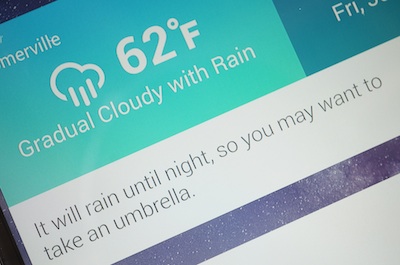 LG has a long history of trailblazing in mobile, and the G3 continues that tradition: its 5.5-inch AH-IPS display features an earth-shattering resolution of 2560 x 1440. It’s not the world’s first 2K smartphone (the Vivo XPlay 3S and Oppo Find 7 beat it to the punch) but it’s the first one from a top-tier manufacturer, and it sure is impressive. It stretches across nearly the entire face of the phone, with only the barest of bezels separating it from the edges. With 538 pixels every inch, you can fit an awful lot of sharp text onto the canvas, and its colors are beautiful.
LG has a long history of trailblazing in mobile, and the G3 continues that tradition: its 5.5-inch AH-IPS display features an earth-shattering resolution of 2560 x 1440. It’s not the world’s first 2K smartphone (the Vivo XPlay 3S and Oppo Find 7 beat it to the punch) but it’s the first one from a top-tier manufacturer, and it sure is impressive. It stretches across nearly the entire face of the phone, with only the barest of bezels separating it from the edges. With 538 pixels every inch, you can fit an awful lot of sharp text onto the canvas, and its colors are beautiful.
But here’s the thing: you can say the same about a lot of screens on the market these days – 1080p screens that don’t require as much power to operate, and which shine a lot brighter in broad daylight than the dense panel on the G3. While it’s not unusable in the sun, it is notably dimmer than much of its competition, and the glossy Gorilla Glass 3 protecting those pixels brings a lot of glare to boot. Whether class-leading pixel density is worth those sacrifices is up for debate: for our part, we appreciated the display, but it didn’t “wow” us every time we turned it on. As we discussed on this week’s podcast, the tiny step from 1080p to 2K is nothing like the jump from 720p to 1080p was: the image quality benefits here are far more subtle, and the costs more significant.

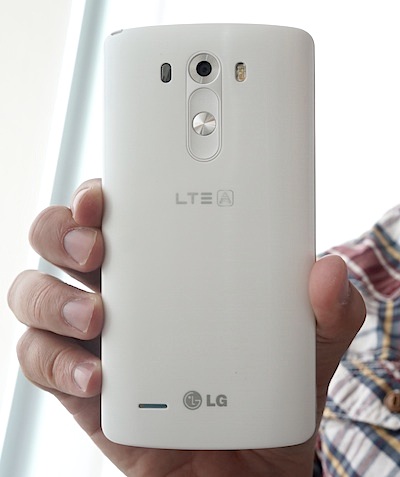 And it’s only by taking your focus off that much-ballyhooed display that you start to see the G3′s other qualities. Its “Floating Arc” chassis is angular in a very sleek, modern way that evokes the image of an airfoil – but with subtle, strategically placed curves, it’s also surprisingly comfortable to hold. At 149g it’s lightweight, but not too lightweight. At 8.95mm, it’s thin enough to slide easily into a pocket, yet substantial enough at the centerline that it’s comfortable to type on. And perhaps most importantly: it doesn’t feel big enough to boast a 5.5-inch display.
And it’s only by taking your focus off that much-ballyhooed display that you start to see the G3′s other qualities. Its “Floating Arc” chassis is angular in a very sleek, modern way that evokes the image of an airfoil – but with subtle, strategically placed curves, it’s also surprisingly comfortable to hold. At 149g it’s lightweight, but not too lightweight. At 8.95mm, it’s thin enough to slide easily into a pocket, yet substantial enough at the centerline that it’s comfortable to type on. And perhaps most importantly: it doesn’t feel big enough to boast a 5.5-inch display.
That’s thanks to the edge-to-edge nature of the G3′s display, which has once again necessitated LG’s distinctive rear-mounted control collective. Their position beneath the camera lens is still an acquired taste, but the volume and power/standby keys are now much easier to find by feel, and they also boast richer, bolder mechanical feedback and a more attractive look. It’s possible to wake the screen without using the rear key via a double-tap on the display; as with every other implementation of this feature, its reliability is hit or miss, but it’s still handy enough that we don’t mind the occasional misfire.

While we really like the look and feel of the G3, we’re a bit worried about its resilience in the long term. The back cover’s matte finish protects the faux-metallic detailing from fingerprints, but it offers no such protection from scratches, scuffs, and dents, all of which our review unit displays in abundance after just a few weeks of use. It’s a shame LG couldn’t incorporate the self-healing coatingfrom the G Flex here, as this is a slippery phone that’s pretty easy to drop; you’ll almost certainly need a case to protect its soft plastic. Fortunately LG has one available for purchase that looks pretty slick.
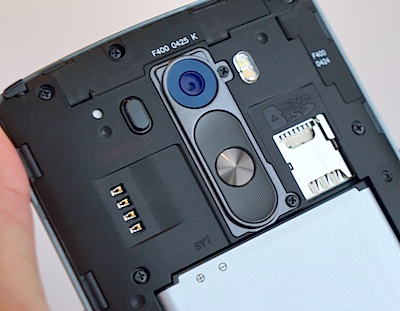 The specs underneath that soft exterior are anything but. A 2.5GHz Qualcomm Snapdragon 801 (MSM8974) provides the beating heart of the device, backed up by 3GB of DDR 3 RAM and 32GB of onboard storage, about 24GB of which is available to the user. (Note that these values are specific to our Olleh unit from South Korea: 16GB variants with 2GB RAM will be offered in some markets.)
The specs underneath that soft exterior are anything but. A 2.5GHz Qualcomm Snapdragon 801 (MSM8974) provides the beating heart of the device, backed up by 3GB of DDR 3 RAM and 32GB of onboard storage, about 24GB of which is available to the user. (Note that these values are specific to our Olleh unit from South Korea: 16GB variants with 2GB RAM will be offered in some markets.)
Under the removable back cover sits a user-replaceable 3,000 mAh battery –with Qi wireless charging on some models– alongside slots for a miniSIM and a MicroSD card of up to 128GB. WiFi 802.11 a/b/g/n/ac, Bluetooth 4.0 LE (APT-x), NFC, USB 2.0 HS, and applicable GSM/HSPA/CDMA/LTE cellular radios round out the connectivity side of this outstanding hardware package.
Software
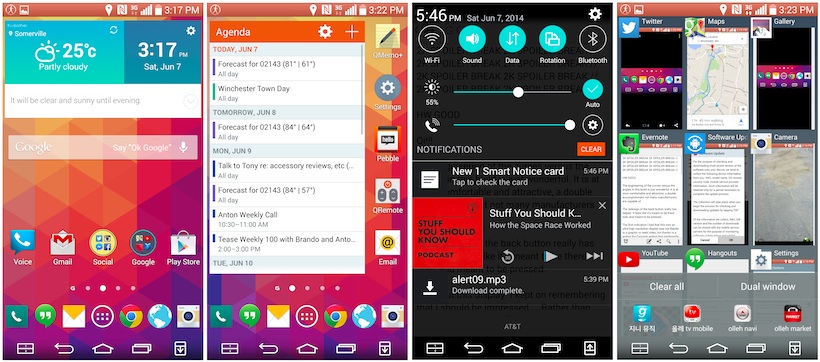
All that high-end hardware means the software remains largely fluid despite all the pixels that need pushing up front, and despite LG’s continued insistence on customizability at almost every level of the user interface.
That interface is the latest LG skin riding atop Android 4.4.2, a UI that’s both reasonably attractive and easy to use. The “simplicity” that the company prides itself on offering here is deceptive: it comes not from reducing the number of frivolous features found on previous builds, but from obscuring them behind a flat, plain design.
There are even new features to be found: Knock Code is little more than a dumbed-down Android pattern unlock, but it’s a fun way to unlock the phone and it provides a modicum of security. The Settings menu is still dense, but here it’s arranged intelligently, organized into tabs that actually make sense. And the ability to define your own home keys down below, including a toggle for the notification shade so you don’t have to reach up to the top of the screen to read your messages, is just brilliant. You can also use the custom home keys to trigger split-screen multitasking to make the most of that big display (though some popular apps like Twitter still aren’t compatible with this mode). Even the new color scheme, which we thought dingy and dull at LG’s announcement, looks great in person, giving the interface a sense of unity.
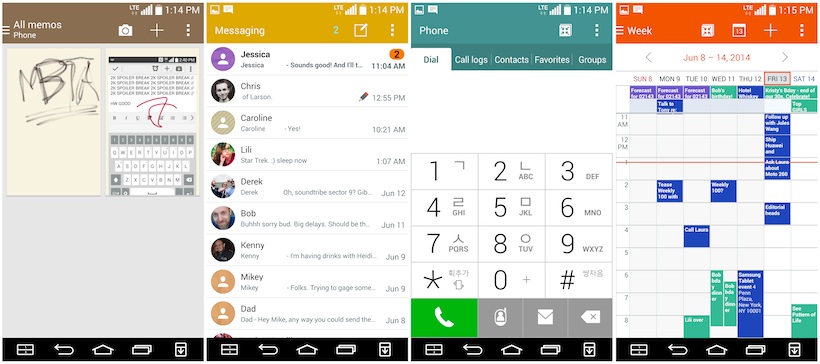
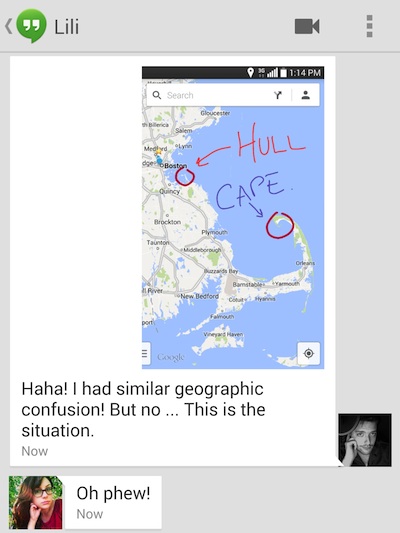 There’s still the inevitable cruft and chrome that comes with all manufacturer software, of course. The multitasking screen resembles that of the HTC One M8 with its large 3×3 card grid, but here it’s crowded and confusing – and swiping cards sideways to close them isn’t intuitive at all in this arrangement. Custom LG shortcuts now reside in the Google Now swipe-up, and while QMemo’s “draw on the screen” functionality actually does come in handy sometimes, we don’t see why LG is pushing its own voice assistant in QVoice when Google’s excellent voice interface is available through the same gesture.
There’s still the inevitable cruft and chrome that comes with all manufacturer software, of course. The multitasking screen resembles that of the HTC One M8 with its large 3×3 card grid, but here it’s crowded and confusing – and swiping cards sideways to close them isn’t intuitive at all in this arrangement. Custom LG shortcuts now reside in the Google Now swipe-up, and while QMemo’s “draw on the screen” functionality actually does come in handy sometimes, we don’t see why LG is pushing its own voice assistant in QVoice when Google’s excellent voice interface is available through the same gesture.
We have the same question about the Smart Notice feature, which has a lot of theoretical functionality, but which in practice usually doesn’t do more than give us a rather verbose weather report (which is usually wrong). More than once we’ve squinted through the blinding sunlight to read the G3′s announcement that “it will be rainy until late at night so you may want to bring an umbrella.”
Fortunately for LG, the good more than outweighs the bad here. Typing on the new LG keyboard is a real pleasure: thanks to its persistent number row, adjustable height, and ability to learn which keys our fingers favor, it’s one of the only stock keyboards we don’t immediately want to replace out of the box. Those who appreciate good audio feedback will love it too: the keyboard’s sounds are crisp, light, and just as loud as they need to be without getting annoying – which goes for the rest of the phone’s sound effects as well.
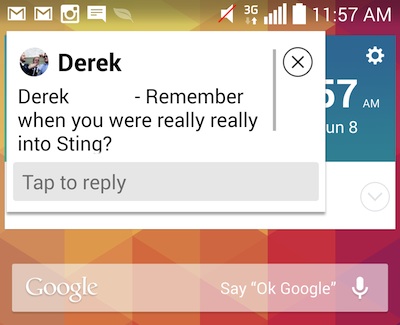 While we still don’t see much use for LG’s floating-window Qslide apps (which the company has sensibly toggled off by default) we have warmed up to the floating notifications for messages. While it’s more intrusive than a standard Android notification, getting text messages in a pop-up window is sometimes more convenient because you can read the entire message without waiting for it to scroll. Also, you can reply right from the notification without needing to open the Messaging app if you like, or just ignore it: the window stays out of the way in the top corner and doesn’t interrupt whatever you’re working on (unless you happen to be engrossed in a movie or a game, in which case you’ll want to disable this feature right away).
While we still don’t see much use for LG’s floating-window Qslide apps (which the company has sensibly toggled off by default) we have warmed up to the floating notifications for messages. While it’s more intrusive than a standard Android notification, getting text messages in a pop-up window is sometimes more convenient because you can read the entire message without waiting for it to scroll. Also, you can reply right from the notification without needing to open the Messaging app if you like, or just ignore it: the window stays out of the way in the top corner and doesn’t interrupt whatever you’re working on (unless you happen to be engrossed in a movie or a game, in which case you’ll want to disable this feature right away).
It’s smart, cool stuff like this that makes using the G3 an interesting and fun experience, and you can find it all over the interface.
Camera
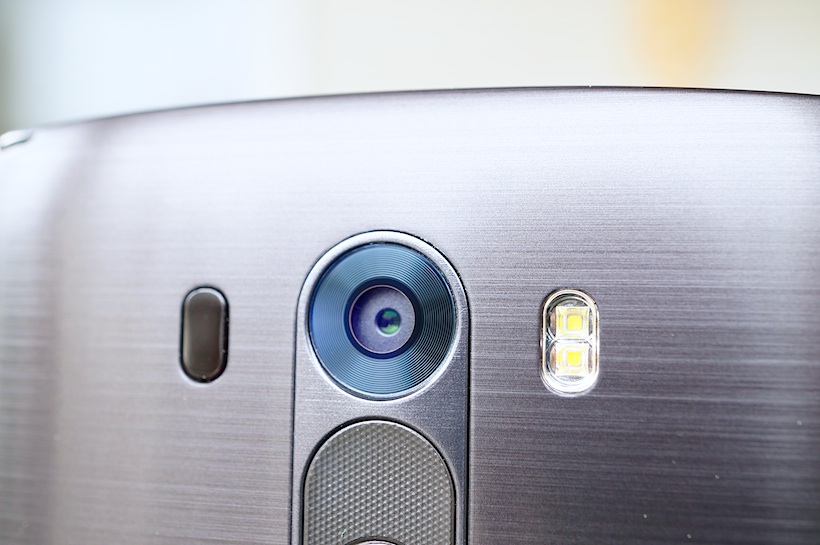
It’s also much easier to take a photo on the G3 than on previous LG devices. Instead of the big thumbnail grid of yesteryear, the G3’s viewfinder is spartan almost to the point of blandness. You’ll need to place a lot of faith in the automatic mode; there’s no dedicated Night setting or anything similar. The “fancy” stuff is confined to a voice activated shutter (which we could only get to respond to “Kimchi”) and hand recognition software that snaps a selfie with the 2.1MP webcam when you make a fist. That latter feature works very well, but all things being equal we’d rather have a hardware shutter key. While a long press on the down-volume button will launch the camera from standby, it’s not quick, and it doesn’t work if you’re listening to audio while you’re trying to take a picture.
The 13MP primary camera does a good job in favorable lighting. Even shooting in the default 10MP setting to preserve a 16:9 aspect ratio, resolution is sharp enough to give you room to zoom, and the software seems to favor vibrance and saturation over authenticity. That’s not a complaint, mind you: the added bit of color makes for very pretty photos, and it’s also common for most modern smartphones to pepper in a bit of pizzazz. The added color is particularly welcome when using LG’s HDR mode, which does a good job of bringing out the detail in the shadows without applying much artificial halo or imparting the grain we sometimes see in competitors’ HDR captures.
The camera’s new hardware works well: its focus-assist laser usually does a good job of quickly setting a focal point, and the hardware stabilization provides a steady viewfinder image. The OIS+ also helps out in video, which we tested in 1080p though the camera is capable of resolution up to 4K. It’s fine in daylight, with great colors and smooth shooting even while being jostled around.
Performance suffers in low light, though, and you’ll notice (in the gallery above) that this applies to still shots as well. Anywhere there’s bright light in a dim scene, the G3 tends to overexpose. Also, colors seem washed-out in low light, and as usual there’s a fair bit of digital noise as well. None of this is unique to the G3, but this merely average low-light performance is disappointing considering some of the great night shooting abilities we’ve seen fromSony, HTC, and Nokia, among others.



































































No comments:
Post a Comment